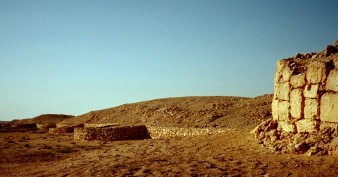

To next page
Note on Daibal or Debal or Daibul or Daybul
which maybe the archeological site of Banbhore
-----------------------------------------------
The site of Banbhore (which is probably Daibal) stands among desolate salt flats on a former mouth of the Indus, situated on the northern bank of the GHARO creek on the highway to Hyderabad 60 kilometers from Karachi and 40 kilometers from the present-day coast. As the only major site in a sparsely populated region, it is often - and plausibly - identified as Daibal. Excavations revealed that Banbhore was already occupied in the first few centuries A.D. Like Siraf and Sohar, it flourished in the ninth and tenth centuries. The site conceals the remains of a settlement of considerable size. The early Islamique site (after 720) is dividend into two parts; a well fortified citadel area measuring over 2000 feet from east to west and 1200 feet from north to south, and an outer enwalled city extending over a large area on the north and east round an ancient lake. Deep diggings at half a dozen points have provided an almost complete cross-section of the mound from top to bottom, revealing the remains of three distinct periods-the Scytho-Parthian, Hindu-Budhist and early Islamic-datable from the 1st century B.C.-to 13th Century A.C. The city was completely destroyed in the 13th century when it was sacked and burnt by the Afghan invader, Jalal-ud-din. It may have been called Barbaricon, Barbari, Debal and Banbhore through the centuries.
Like Siraf, Banbhore stood on a barren coast, which could not have supported a town without the wealth generated by trade. It served as a port of call for ships voyaging between India and the Gulf, and as the outlet for commodities from up country: lapis lazuli (from the Hindu Kush), musk (from the Himalayas), indigo and other items of trade.
In 711 AD, the Arabs, led by Muhammad Bin Qasim, landed at Debal near modern Banbhore and ruled the lower half of Pakistan for 200 years,. During this time, Islam took roots in the soil and influenced the life, culture and traditions of the people.
Juma, Abdurahman (2004). in his doctoral theses on Unguja Ukuu on Zanzibar: An archaeological study of early urbanism
A stone well at Unguja Ukuu together with several other early monuments of the east African coast that survive on the site have been attributed to the Wadebuli, suspected by early scholars to be people of Arab descent from their colonies in India or elsewhere on the Islands of eastern Indian Ocean.
Unguja Ukuu is a large site (c.16�17 ha) and a major center of an African iron-using farming community who occupied it from c. 500 AD. The settlement got abandoned c. 900. Unguja Ukuu was a key urban centre built of mud and timber structures.
Chittick 1965
It is now believed that the Debuli arrived before the Shirazi and that their name derives from the town of Debul, known to the Arabs who conquered it in A.D. 711-712 as Daybul, a port situated near the mouth of the Indus. It is now identified with the excavations at Bhambor, 40 miles east of Karachi
Current Antropology vol 38 1997 F.A. Chami
The site of Unguja Mkuu has yielded a wide variety of imports from India, the Middle East, and the Roman world, all dated 5th to 7th century AD (Juma 1996) including pottery, glassware, beats, alabaster, and various kinds of metals. The side of Misasa is seawards of Limbo on the coast. Its cultural materials are very similar to those from Unguja Ukuu, suggesting that the latter was an emporium from which traders crossed the channel to mainland settlements (Chami 1994)
By the beginning of the 7th century trade with India, Mesopotamia, and the Mediterranean had penetrated farther into the interior, and at this point Unguja Mkuu was probably the trade center.
Red Sea trade and travel 2002 F.A. Chami
In a cave in Zanzibar he found Red Roman Ware pottery, non glazed Persian wares, and Indian beats (including a carnelian beat) from the last century BC.
From Mafia island from the same period Graeco-Roman and Indian ceramics. Another important find in the same site is red painted ware of Indian origin from the early centuries AD. Another class of pottery (found in the same site) belonged to the early iron age of India. More then 25 potsherds recovered from the island of Mafia have been identified as of Indian origin.